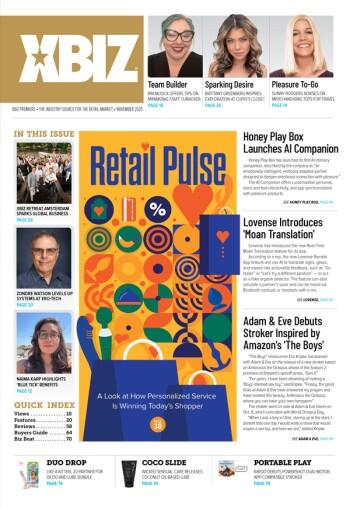Working in the adult industry requires an open mind. This helps to make the job more fun and rewarding. You might be surprised, however, at how many preconceived notions many of us still hold about the customers we serve.
I was inspired to write this article after Blush’s Sales Manager Nancy Cosimini shared an experience that involved a pleasure product salesperson and a young millennial looking to purchase her very first sex toy. The salesperson was shocked to learn that this 30-something had absolutely no experience with or knowledge about sex toys, and their assumptions about this shopper prevented them from delivering the best service they could.
People who fit in the same demographic categories often have wildly different experiences.
How do we prevent this? In a perfect world, we could simply let go of all preconceived notions and never make any assumptions based on gender, age or other demographics. But what if we’re not even aware of those assumptions?
Let’s look at three common misconceptions about customers that tend to pop up on the retail floor, and how we can be more aware to avoid those mistakes. After all, knowing your customer is an important part of offering superior service!
Misconception #1: Young women are in the know about sex toys.
A lot of the people working in adult retail spaces are young women, which can make it seem like that demographic is particularly sex toy-savvy. It’s important to remember that adult retail is something of a unique bubble. Our bubble is not the norm. Much of the world is unfamiliar with sex toys, and even uncomfortable talking about them. So how do we break away from this misconception?
- Avoid making assumptions based on gender or age. People who fit in the same demographic categories often have wildly different experiences. You really can’t confidently assume anything.
- Make space for discomfort or confusion from shoppers and be prepared to offer positive-neutral information, affirmation and validation — especially if they exhibit strong feelings or reactions.
- Start by asking questions like "How familiar are you with pleasure products?" or "Is there anything you've been curious about?" instead of launching into product recommendations or overwhelming them with a list of features and benefits.
- At first, treat shoppers as though they know nothing about pleasure products. Let them help guide the conversation by sharing what they do or don’t know, and pay attention to the information they give you before responding.
Misconception #2: Men are clueless about sex toys and probably intimidated by them.
Unfortunately, the gendering of sex toys as a “woman thing,” plus a helping of unrealistic standards for masculinity, have left many people believing that men know nothing about vibrators and are probably resistant to using them with a partner. I often laugh about this assumption because my co-founder at Blush, Eric Lee, is not only a self-proclaimed sex toy geek but also my husband! Consequently, we understand that stereotypes about male shoppers are often wrong. Here are some things to keep in mind to help you avoid the trap of inaccurate assumptions:
- Again, avoid making assumptions based on gender. It’s absolutely true that some men lack sex toy knowledge, and also true that some heterosexual men feel unsettled by a vibrator as though it’s competition. But you might be surprised by how many heterosexual men are not only curious about sex toys but also have prior experience with using vibrators — often thanks to the labor of previous partners.
- On the sales floor, rather than making immediate product suggestions, start by asking questions about the kind of experience customers are looking for. Do they want something that can be used during vaginal intercourse? Or something that can stimulate both partners at the same time? Do they need something that’s comfortable to hold for long periods of time? There are all kinds of factors that go into the selection process and asking experience-centered questions can help you quickly narrow down the options without requiring shoppers to know or understand brands, product features or functions.
- Some men come into stores specifically to find a product they heard about on a podcast or saw their partner ogling in a magazine. Don’t be surprised if he already did a bunch of research about the item before coming in to buy it.
- As always, make room — and find empathy — for nervous newbies who don’t know where to start or how to feel about the products you’re showing them.
- Also keep in mind that we often make assumptions about a shopper’s sexual orientation or partners based on what they’re shopping for. Looking at a clitoral vibrator doesn’t necessarily mean his partner is a woman, and having a cisgender female partner doesn’t necessarily mean he is heterosexual.
Misconception #3: Women over 50 are new to and uncomfortable with sex toys.
A lot of folks assume that people over the age of 50 are inherently more conservative and less open-minded about things like sex toys. Pair that with the ageist and sexist assumptions that older people don’t understand technology and that postmenopausal women have no sexual desire, and you’ve got a recipe for unfair judgment. Here’s what you want to keep in mind to ensure you give these shoppers the best experience possible:
- Avoid assumptions based on age — you knew I was going to say that, right? Data from home toy party companies shows that female shoppers older than 50 account for some of the biggest sales.
- Many shoppers in this age range are curious, empowered and have budgets that allow them to invest in products that excite them.
- Start by asking open-ended questions that let them guide the conversation instead of assuming you need to start with the basics.
- Use their responses to help them find the best options for them, whether that’s an entry-level vibe or an elaborate BDSM setup. You might be surprised by how little pearl-clutching actually happens with these shoppers!
- Also avoid presuming that a 50- or 60-something woman shopping for a vibrator is divorced, widowed or unpartnered, and that they’ll be using it solo. Many of these women are having some of the best sex of their lives, with and without partners — or the sex toy they might buy from you.
Drop the misconceptions, gain big sales
Providing your customers with an amazing experience means paying attention to any assumptions you may tend to make based on gender, age, sexuality or other attributes. It means ditching your expectations and allowing shoppers to show you who they are — or making space for them not to show you who they are, since you don’t have to know anything personal about them to give them fantastic product recommendations. This will not only improve their shopping experience, but also communicate that your store is a safe and respectful place for them to shop, something they will absolutely spread the word about.
Verna Meng is the co-founder and CEO of Blush, and the recipient of the 2018 International Women’s Entrepreneurial Challenge Foundation Award.








